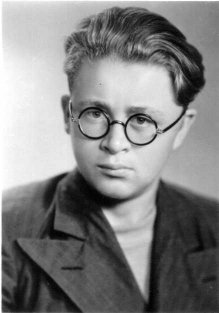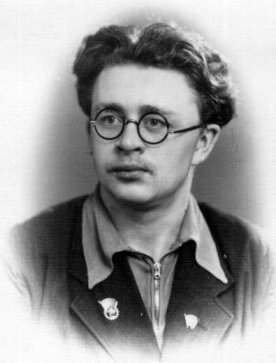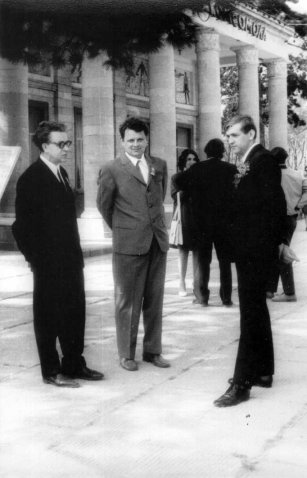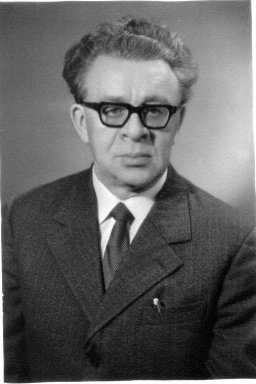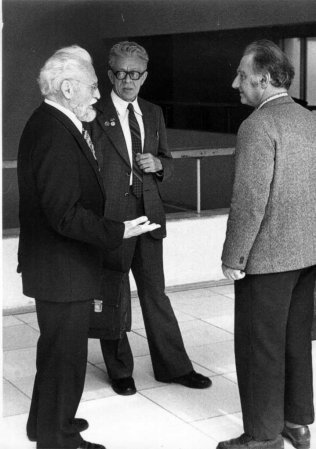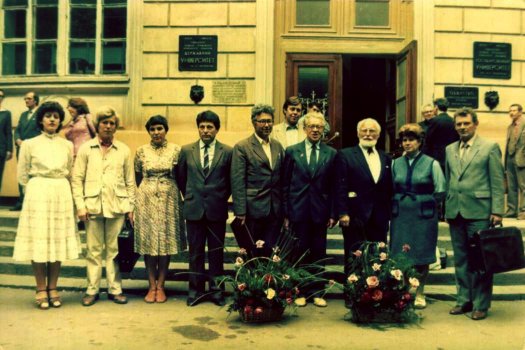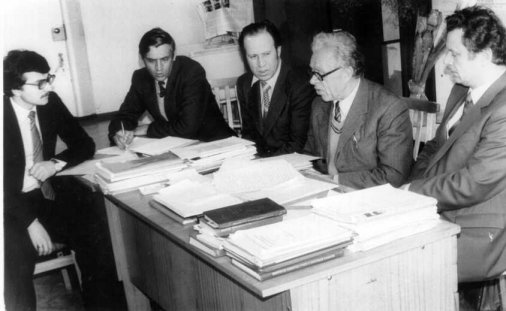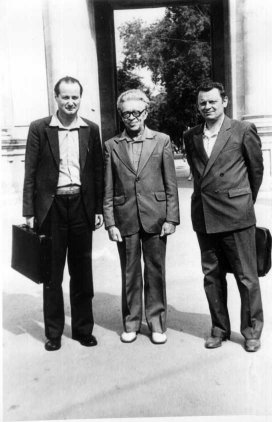|
PROFESSOR A. M. ZAMORZAEV (1927-1997) AND KISHINEV SCHOOL OF DISCRETE GEOMETRY
1. Alexandr Mikhailovich Zamorzaev (E. S. Fedorov Prize of AS USSR winner, State Prize of Moldova winner, Honour Scientist of Moldova, Corresponding Member of AS Moldova, Professor) would be 75 on January 23, 2002. A. M. Zamorzaev was born in Leningrad (now the city of Sankt-Peterburg). His father was an electrical engineer, his mother worked as bibliographer and proof-reader. In June 1941, when Alexandr finished the 7th form of the school, he was fond of poetry and mathematics. By that time his plans for future became clear: secondary school and then faculty of mathematics of the university. But the war began, and 14 years old Alexandr, together with his two sisters and younger brother, were evacuated from Leningrad, at their mother's urgent request. The boarding school for children of Leningrad journalists settled at first in Yaroslavl Region and since November 1941 in Tatarian Autonomous Republic. Since the first days A. Zamorzaev, together with other senior pupils, worked in fields, cut firewood, helped to bring to school water, bread, took part in amateur performances and so on. That winter he did not go to school, because only seven-year school was in the village. Soon after the blockade was liquidated, Alexandr Zamorzaev came back to Leningrad. The defence industry began to revive in the city, and many workers were wanted for defence plants. Alexandr worked as metal turner and continued his study at a night school. In 1945 he finished the secondary school with gold medal and entered the Leningrad State University, the Faculty of Mathematics and Mechanics.
Figure 1: 1945 A. M. Zamorzaev
finishes the school (Leningrad).
Figure 2: 1946 A. M. Zamorzaev is a second-year student (Leningrad). In 1950 A. Zamorzaev graduated from the university and became a post-graduate student at the Department of Geometry of the same university. His scientific adviser was the greatest geometer of the country A. D. Alexandrov. In 1953 A. Zamorzaev defended doctor dissertation entitled "Generalization of Fedorov groups", in which he transferred Shubnikov antisymmetry from point symmetry groups to space symmetry groups.
Figure 3: 1950 A. M. Zamorzaev graduates from the university (Leningrad). In 1953 young Doctor of Science A. M. Zamorzaev could remain to work in his native city of Leningrad, but he decided to move to a place where specialists were needed most of all. So, he and his wife Anna Andreevna chose Kishinev, because the newly established Kishinev University lacked lecturers. At that time the author of these lines was the first year student at the Mathematics Division to whom the course of analytical geometry was not delivered. 2. In October 1953, when Alexandr Mikhailovich came to Kishinev, only two lecturers worked at the Department of Geometry and Algebra and he was the third doctor of science at the Mathematics Division. A. M. Zamorzaev began to deliver "vacant" courses, in 6 subjects (higher algebra, calculus of variations, analytical and differential geometry, geometry foundations, Riemannian geometry), to supervise a special seminar and 5 graduate students. Not only managed he to bear such hard working, he also managed to lay foundation for further fruitful scientific research. During this first year at the Kishinev University A. M. Zamorzaev together with his graduate student E. I. Sokolov began to develop antisymmetry of different kinds, extending A. V. Shubnikov antisymmetry by ascribing not one, but l different signs "plus" or "minus" to points of the figure under transformation. A. M. Zamorzaev actively did research, showing mathematical imagination, developed his own topics, working away from his scientific adviser. In 1955-1956 graduate students under his supervision continued investigations on antisymmetry of different kinds. 3. For the purpose of profound study of geometric topics in 1955 A. M. Zamorzaev proposed to organize the specialization of students. And in 1957 the first students-geometers graduated from the university. Eight of 10 graduates, including the author of these lines, carried out the derivation of generalized Shubnikov space groups for l = 2. Altogether 14 works of graduate students were devoted to multiple antisymmetry during 1954-1957. In 1957 in the issue of the journal "Kristallografiya" devoted to the 70th birthday of Academician A. V. Shubnikov two papers of A. M. Zamorzaev were published: "Generalization of Fedorov groups", covering results of his dissertation and "Symmetry and antisymmetry of different kinds of finite figures" (co-author E. I. Sokolov), covering works of his graduate students. These papers drew attention of foreign reviewers A. L. Mackay (Great Britain) and W. Nowacki (Switzerland). Graduates of 1958-1960 under the supervision of A. M. Zamorzaev did Study in the hyperbolic (Lobachevsky) geometry (regular and semiregular polygons and polytopes, including with vertices on the absolute, elements of the theory of symmetry, new interpretations) and related problems of axiomatics (axioms of spherical, elliptic and other geometries). A. M. Zamorzaev marked out work of graduate of 1958 L. Gerasimenko, who began the construction of quasi-affine axiomatics of Lobachevsky geometry, works of graduates of 1959 V. Makarov, who investigated semiregular polygons on the Euclidean and Lobachevsky plane, A. Rusanov, who studied regular polytopes with vertices on the absolute, circumscribed about the sphere and orisphere in the Lobachevsky space, A. Gametsky, who described motions of the Lobachevsky space by means of pseudo-orthogonal matrices of the 4th order, and also investigations of graduate of 1961 Yu. Ryabukhin on some axiomatics problems. 4. For geometry specialization new specialists-geometers were needed. In 1960 A. M. Zamorzaev organized a scientific seminar on mathematical problems of crystallography, his former graduate students became its participants, further it became the Kishinev seminar on discrete geometry. Specialists not only from Moldova, but also from other scientific centres had talks at the seminar. Already in 1962 the supervisor of this seminar and his disciples A. F. Palistrant and E. I. Galyarsky delivered 3 lectures at the First All-Union Geometry Conference in Kiev: "Theory of antisymmetry, its extensions and applications", "Groups of symmetry and antisymmetry of different kinds of layers" and "On similarity symmetry and antisymmetry groups". In 1962-1963 the seminar was joined by V. S. Makarov and A. F. Gametsky, who finished post-graduate courses in Kiev and Moscow, respectively. In spring 1963 outstanding geometer, Corresponding Member of AS USSR B. N. Delone came to Kishinev and delivered a cycle of lectures. Some of problems formulated by B. N. Delone in his lectures were solved by Kishinev geometers in 1964. V. S. Makarov proved, by means of geometry, that the number of non-isomorphic Fedorov groups in the Lobachevsky space is infinite (the similar fact on the plane was known already in XIX century). A. M. Zamorzaev constructed several infinite series of non-normal (non-face-to-face) regular (tile-transitive) tilings of the Euclidean space, thus refuting the hypothesis of Delone that it is possible to construct the theory of stereohedra by means of topology (what Delone did for the theory of planigons). Both results were approved by B. N. Delone and recommended by A. D. Alexandrov for the publication in "Doklady AN SSSR". V. S. Makarov was invited by Delone to work for three years at the Mathematical Steklov Institute of AS USSR. In conclusions of the Second All-Union Geometry Conference held in 1964 in Kharkov the Kishinev University was considered the second in USSR (after MI AS USSR) scientific centre in discrete geometry. V. S. Makarov, under the supervision of B. N. Delone and A. M. Zamorzaev, prepared and defended in 1966 at MI AS USSR the doctor dissertation "To the theory of tilings of the Lobachevsky space", in which for the first time so called non-arithmetical discrete symmetry groups of the Lobachevsky space were found. 5. In 1963 three students began post-graduate studies in the field of geometry and topology under the supervision of A. M. Zamorzaev. A. F. Palistrant by that time completed the derivation of two-dimensional, layer, frieze and band groups of multiple antisymmetry and began the study of colour symmetry and colour antisymmetry by N. V. Belov. E. I. Galyarsky by that time had worked as assistant for two years and developed the theory of two-dimensional similarity symmetry and antisymmetry groups. I. A. Baltag, graduate of 1954, began to construct the theory of Fedorov groups in the plane and space of pseudo-Euclidean Minkowski geometry. During 1963-1966 the author of these lines extended N. V. Belov's theory of colour symmetry and antisymmetry, completed the scheme of crystallographic groups with invariant plane for multiple antisymmetry, colour symmetry, simple and multiple colour antisymmetry and prepared his doctor dissertation. E. I. Galyarsky for these years studied two-dimensional and conic groups of similarity symmetry and antisymmetry of different kinds, fully derived crystallographic groups of multiple antisymmetry of rods and began to transfer the ideas of colour symmetry and antisymmetry to all these groups. I. A. Baltag basically completed the derivation of infinite series of two-dimensional pseudo-Euclidean Fedorov groups and in part studied three-dimensional ones. A. M. Zamorzaev, besides the collaboration with his post-graduate students, intensively developed the theory of P-symmetry, the widest generalization of Shubnikov antisymmetry and Belov colour symmetry, where the rule of the change of qualities, ascribed to points, is combined directly with geometric transformation and does not depend on the choice of points. Investigations, carried out by A. M. Zamorzaev and his students during the 60-ties on the topic "Mathematical problems of crystallography", drew attention of some scientists from the Institute of Crystallography of AS USSR. On April 29, 1964 A. M. Zamorzaev delivered a review lecture "Antisymmetry and its different generalizations" at a session of Scientific Council. The topic of investigations was approved and the lecturer was suggested to prepare a monograph. One can find detailed elucidation of works by A. M. Zamorzaev and his disciples published in the 60-ties in articles [1, 2] and monographs [3-5]. 6. The mentioned above efforts of A. M. Zamorzaev in the direction of organizing scientific research and training lecturers-geometers during 1966-1973 were a success.
Figure 4: A. M. Zamorzaev, A. F. Palistrant, P. A. Zabolotny (Kishinev). In 1966 some changes took place at the Department of Algebra and Geometry. V. D. Belousov, who just defended at the Moscow State University a doctor habilitat dissertation on the theory of quasigroups and loops, became the head of the department. Lecturers who were not engaged in scientific research left the department for other institutions, and positions at the department were taken by geometers A. F. Palistrant, E. I. Galyarsky, I. A. Baltag. All this permitted to establish in 1967 two specializations for students at the department: in general algebra and discrete geometry. A. M. Zamorzaev for two years took the position of senior researcher in order to complete his doctor habilitat dissertation. Special courses on geometric transformations, mathematical crystallography, theory of tilings, multi-dimensional spaces, supplementary chapters of higher geometry, projective geometry and Riemannian geometry became traditional for geometers. Since 1969 all geometers of the department supervised graduate students, involving them in research related to the topics of their dissertations. During 1967-1971 4 dissertations were defended by lecturers of the department: A. F. Palistrant - "Planar and space groups of symmetry and antisymmetry and their applications" (May 1967); I. A. Baltag - "To the theory of Fedorov groups and regular tilings of the pseudo-Euclidean space" (April 1969); E. I. Galyarsky - "Similarity symmetry groups and their generalizations" (February 1971); A. M. Zamorzaev - "Theory of antisymmetry and its different generalizations" (doctor habilitat dissertation, June 1971).
Figure 5 Thus, by 1973 a strong group of geometers formed at the Department of Algebra and Geometry, and the specialization of students in geometry became more profound: a special course on the theory of antisymmetry and its different generalizations was developed by A. M. Zamorzaev, students took active part in the scientific seminar. P. A. Zabolotny, post-graduate student of A. M. Zamorzaev, was in the reserve of the department. He graduated from the university in 1970 and already in his graduate work under the supervision of A. M. Zamorzaev made an essential contribution to the theory of homology of crystals by V. I. Mikheev, generalizing Mikheev point homology with the idea of antihomology; during his post-graduate study P. Zabolotny found all space homology groups. In 1972 and 1973 I. Gutsul and A. Lungu graduated from the university, in their post-graduate works under Zamorzaev's supervision they supplemented his doctor habilitat dissertation with some results in the theory and classification of P-symmetries. 7. In the beginning of 1973 the Department of Algebra and Geometry divided into two parts - the Department of Higher Algebra and the Department of Higher Geometry, the latter headed by Professor Zamorzaev, all his further activity being close connected with this department. In September 1973 the Department of Higher Geometry consisted of lecturers with common topics in generalized symmetry. After finishing the post-graduate study P. A. Zabolotny joined the department and submitted the dissertation "To the generalization of Mikheev homology groups". At the department the scientific seminar continued to intensively work, both the activity of scientific student groups and the level of graduate students' works increased. In 1974 the department published the collection of papers [6], edited by A. M. Zamorzaev and containing results of students I. S. Gutsul, A. P. Lungu, V. P. Garit (graduate of 1972), of post-graduate student A. P. Zabolotny, of lecturers of the department, as well as new results of V. S. Makarov and first results of K. P. Makarova on two-dimensional manifolds of constant negative curvature and the behaviour of geodesics on them. Works of A. M. Zamorzaev and his school proved to be up-to-date, and by the beginning of 70-ties they gained a wide recognition. In 1973 Professor A. M. Zamorzaev was awarded the E. S. Fedorov Prize of AS USSR, in 1974 he was awarded the State Prize of Moldova in Science and Technology. In 1975 V. P. Garit joined the department, that time being a post-graduate student, A. P. Lungu began his post-graduate study. I. S. Gutsul changed his topic. He got engaged in the research of discrete groups of the Lobachevsky space and hyperbolic manifolds under the supervision of V. S. Makarov and in 1976-1980 took post-graduate courses at the department. The scientific adviser of all post-graduate students of the department was A. M. Zamorzaev, that time the only doctor habilitat. V. S. Makarov delivered special courses on the theory of discrete symmetry groups in the Lobachevsky space since 1978, supervised graduate students at the department, and in 1981 he defended his doctor habilitat dissertation. Thus, teaching and scientific initiatives of A. M. Zamorzaev resulted in the fact that the small group of A. M. Zamorzaev's disciples of the 50-ties grew, by the late 80-ties, to Kishinev geometry school consisting not only of doctors, but also of doctors habilitat of science. In 1977 Professor A. M. Zamorzaev was awarded the title of Honour Scientist of the Republic of Moldova. Monographs of 1976 and 1978 [3, 4] contained results of A. M. Zamorzaev's doctor habilitat dissertation and latest results of E. I. Galyarsky and A. F. Palistrant. The developed methods of application of P-symmetry groups to the description of multidimensional crystallographic symmetry groups with invariant two- and three-dimensional planes were reported by A. F. Palistrant in 1978 at the XI International Congress of Crystallographers in Warsaw. The results were approved by V. A. Koptsik, Professor of the Moscow State University, and by Academician N. V. Belov and arose interest of crystallographers and physicists from other countries. 8. On the initiative of A. M. Zamorzaev the department strengthened the scientific collaboration with geometers of the Mathematical Steklov Institute of AS USSR, crystallographers of the Moscow Lomonosov State University and of the Leningrad Plekhanov Institute of Mines, not mentioning old connections with the Crystallography Shubnikov Institute of AS USSR; contacts with geometers from Novosibirsk were established. In particular, in 1973 and 1975 A. M. Zamorzaev was a scientific referee of dissertations defended by students of Professor V. A. Koptsik, in these dissertations the authors, using other methods, derived Belov groups of p-symmetry [7] and scheme of crystallographic P-symmetries [6, pp. 18-22], developed the theory of Q-symmetry (more convenient for describing physical phenomena in crystals) and the extension of Zamorzaev P-symmetry as W-symmetry (where the rule of change of qualities ascribed to points depends on the choice of points). Soon after that A. P. Lungu, following A. M. Zamorzaev's suggestion, extended the theory of P-symmetry [8], constructed general theory and the classification of groups according to types, at the same time developing group-theoretical methods. In 1980 he submitted his dissertation. 9. In late 70-ties the Department of Geometry began to train post-graduate students specially for higher schools of Moldova. In 1977-1980 Yu. S. Karpova, from the Tiraspol State University, took post-graduate course. She studied space groups of some P-symmetries. In 1981-1984 L. K. Magalyas, from the Beltsy Pedagogical Institute, took post-graduate course. Their scientific adviser was A. M. Zamorzaev. In 1973-1982 scientists from A. M. Zamorzaev's school won a wide world recognition. Evidences of this fact are the following: the mentioned above participation of A. F. Palistrant in Warsaw Congress of Crystallographers and the paper [9] in an international journal written on the invitation of Swiss crystallographers, the visits, for consultation purposes, of geometers E. Horvat from Hungary (1979), H. Hertel from Germany (1982), the participation of A. M. Zamorzaev, A. F. Palistrant, A. P. Lungu and Yu. S. Karpova in International Seminar on Group-Theoretical Methods in Physics [10-11] (Zvenigorod, 1979 and 1982). One more evidence was All-Union Symposium on Theory of Symmetry and its Generalizations held on the basis of the Department of Geometry in 1980, with guests from all parts of the Soviet Union and from Hungary [12].
Figure 6: 1982 Acad. A. D.
Alexandrov, Prof. A. M. Zamorzaev,
During the first nine years of its existence the Department of Geometry not only trained specialists, but also made progress in the research of both crystallographic and non-crystallographic P-symmetries, when the group P of permutations of qualities ascribed to points of the figure under transformation is isomorphic to symmetry groups different from 32 crystallographic classes. Some essential results in this direction were obtained by E. A. Zamorzaeva in graduate work [14] in 1976. Further E. A. Zamorzaeva took post-graduate course at the Mathematical Steklov Institute of AS USSR under the supervision of B. N. Delone and changed the field of her interest, her investigations on supercrystallographic P-symmetries were continued by Yu. S. Karpova. The monograph [15] contains results on the general theory and classification of P-symmetries, the structure of crystallographic groups of some P-symmetries, the application of obtained results to the description of multidimensional symmetry groups, as well as the technique of Q-symmetry, which is more suitable for the description of physical phenomena in crystals. The results of V. P. Garit's dissertation on the derivation of two-dimensional pseudo-Euclidean Fedorov groups, their extension with the help of antimotions and two-dimensional semi-Euclidean discrete groups obtained in collaboration with I. A. Baltag are elucidated in detail in the monograph [5]. Altogether during the period from 1973 to 1982 geometers of the department defended 4 dissertations: P. A. Zabolotny - "To the generalization of groups of homology by V. I. Mikheev" (June, 1977), A. P. Lungu - "Extension of the theory and classification of P-symmetries" (November, 1980), A. F. Palistrant - "Groups of colour symmetry, their generalizations and applications" (doctor habilitat, October, 1982), V. P. Garit - "Two-dimensional discrete groups of motions and similarities of the pseudo-Euclidean and semi-Euclidean planes" (December, 1982). 10. In 1983-1990 the Department of Geometry and its disciples continued to grow intensively. The beginning of this period was marked by new dissertations being defended: I. S. Gutsul - "Construction of three-dimensional manifolds of constant negative curvature" (June, 1983), Yu. S. Karpova (Chubarova) - "To the derivation of junior space groups of P-symmetry" (November, 1983). In the same year E. A. Zamorzaeva defended at the Mathematical Steklov Institute of AS USSR the dissertation "Investigation of regular tilings for similarity symmetry groups".
Figure 7: 1984 Acad. A. D.
Alexandrov and a group of Kishinev geometers
Further E. A. Zamorzaeva and I. S. Gutsul constituted the main body of the Sector of Geometry headed by V. S. Makarov, that was organized at the Institute of Mathematics of Moldavian AS in 1985, its staff being filled up by graduates of the Department of Geometry. During the mentioned period the Department of Geometry continued to broaden its relations with foreign and Russian scientists. For whole academic year 1983-1984 post-graduate student K. Muller from Germany (scientific adviser H. Hertel) was a guest of the department. I. A. Baltag and A. F. Palistrant visited Hungary with scientific communications. Special guests of the department were E. Molnar from Budapest in 1983 and 1987, S. V. Jablan from Belgrade in 1986 and 1988. A. F. Palistrant visited Belgrade, having established close scientific relations with S. V. Jablan, which resulted in joint publications [16-18]. Geometers of the department took part in some jubilee international seminars and conferences: devoted to the 100th anniversary of A. V. Shubnikov (Moscow, 1987), to the 100th anniversary of the derivation of Fedorov groups (Leningrad, May 1991), to the 100th anniversary of N. V. Belov (Zvenigorod, December 1991). Connections with Novosibirsk became stronger: in 1982 and 1987 geometers of the department participated in Symposium on Geometry "in the Large" held at the Siberian Branch of AS USSR [19, 20]. A. P. Lungu (1984) and P. A. Zabolotny (1985) were special guests at institutes of SB AS USSR, and so on. 11. During the same period some graduates whose scientific advisors were disciples of A. M. Zamorzaev began post-graduate studies.First we would like to mention V. V. Banari, who began to study in detail equiaffine transformations as graduate student and then proceeded, together with I. A. Baltag, to the derivation of Bravais types of lattices in the three-dimensional pseudo-Euclidean space, the number of types both in the plane and space being infinite. Having taken post-graduate course in 1982-1985, Banari together with Baltag developed fruitful methods for the derivation of three-dimensional pseudo-Euclidean lattices [13, 21], and in 1988 she defended the dissertation "Bravais types of lattices of the three-dimensional Minkowski space".
Figure 8: A student, P. A.
Zabolotny, E. I. Galyarsky, A. M. Zamorzaev,
We would like to notice graduates of 1985 V. Balkan and F. Damian, who as graduate students under the supervision of V. S. Makarov began research of non-orientable three-dimensional manifolds of constant negative curvature [22, 23]. V. V. Balkan took post-graduate course at the department under the supervision of Professor V. S. Makarov and in 1990 defended the dissertation "Non-normal regular tilings of the Lobachevsky space". F. L. Damian studied four-dimensional manifolds at the Sector of Geometry of IM ASM, at present he is a lecturer at the Department of Geometry of the State University of Moldova. In 1986 and 1987 the Department of Geometry published two monographs. The book [15] reflects new investigations of A. M. Zamorzaev on P-symmetry (after his doctor habilitat dissertation defended in 1971) and results from the dissertations of A. P. Lungu, A. F. Palistrant and Yu. S. Karpova (defended in the beginning of 80-ties). The book [21] contains results of I. A. Baltag, V. V. Banari and some graduates that were obtained in 1980-1985.
Figure 9: E. Molnar (from Hungary),
A. M. Zamorzaev,
We would like to notice L. E. Solovei, graduate of 1990, who took post-graduate course under the supervision of Associate Professor I. A. Baltag in 1990-1994. She studied properties of n-dimensional lattices of the Minkowski space [24] and transferred to the construction of these lattices for n = 4 geometric methods which were applied in the dissertation of V. V. Banari for n = 3. After having finished post-graduate study Solovei began lecturing at the department and together with A. M. Zamorzaev found new properties of n-dimensional lattices in the spaces of Minkowski and Euclid. In October 1997 she defended the dissertation "Methods for the construction of Bravais types of lattices in the 4-dimensional Minkowski space". 12. A genuine triumph of geometry of the university and all Moldavian geometry was the IX All-Union Geometry Conference held in Kishinev in September 1988 [25], where for the first time the Section of Discrete and Combinatorial Geometry was presented. Scientists from Moscow, Leningrad, Novosibirsk, Omsk, Ivanovo, Tashkent, 29 scientists from Moldova (including 17 persons from the university) took active part in the conference.
Figure 10 Academician A. D. Alexandrov - the scientific advisor of A. M. Zamorzaev during his post-graduate study - came to Kishinev for the first time. Among many problems of the development of geometry discussed at the conference the discussion on the teaching of geometry was the most heated and lively; the tone of discussion was set by Academician A. D. Alexandrov, who that time was actively engaged in preparing new school textbooks in geometry. One can learn about the activity of the Department of Geometry headed by Professor A. M. Zamorzaev in more detail in the paper [26]. 13. In May 1989 A. M. Zamorzaev was elected Corresponding Member of the Academy of Sciences of Moldova. Together with him Yu. M. Ryabukhin was elected Corresponding Member of ASM, the person mentioned above, who obtained as graduate student under A. M. Zamorzaev's supervision interesting results on "quasiaffine" axiomatics of the Lobachevsky geometry [27, p. 65-78].
Figure 11: Acad. A. D. Alexandrov. Having new scientific title, Alexandr Mikhailovich continued to work fruitfully, with his peculiar fervency he lectured on his own special courses, foundations of geometry, history and methodology of mathematics, supervised graduate and post-graduate students, often delivered original lectures for student and pupils, supervised the scientific seminar on discrete geometry and the faculty seminar on philosophical problems of mathematics, took active part in the work of Councils for conferring scientific degrees of doctor and doctor habilitat in physics and mathematics, actively went in for sports. 14. Scientific interests of A. M. Zamorzaev were many-sided. He had works in many directions of geometry: a) axiomatics of different geometries;
Application of Zamorzaev P-symmetry to the investigation of physical properties of crystals opened prospects of its further generalizations developed by Moscow crystallographers. Thorough mathematical substantiation of these generalizations together with complete classification of the obtained groups were the nucleus of doctor habilitat dissertation of A. P. Lungu "Theory of generalized colour symmetry with application of extensions and wreath products of groups" defended in December 1997.
Figure 12 Till his last day, November 1, 1997 A. M. Zamorzaev did not cease working actively. He possessed energy and diligence, a very retentive memory, aptitude for versification. In any situation he could recite not only his own poetry, but also verses of literature classics. He had thorough knowledge of the history of development not only of Faculties of Mathematics and Physics, but also of the State University of Moldova. He was a man of principle, kind, always ready to fulfill any assignment and to help to his disciples and colleagues. For all these features Alexandr Mikhailovich won the deep respect of lecturers, students and all persons who were acquainted with him. The contribution of Professor A. M. Zamorzaev to the development of science and culture of Moldova is huge. He published 110 scientific works, including 3 monographs, and 4 textbooks, which laid new scientific directions in mathematics. He supervised over 100 works of graduate students, 10 doctor and 3 doctor habilitat dissertations were defended under his supervision. 15. In 2002 it will be 5 years since the day Professor A. M. Zamorzaev passed away. His disciples working at the Department of Geometry revere the memory of its founder. Each year on January 23, the birthday of Alexandr Mikhailovich, a session of scientific seminar is held. Geometers of the department take part in international geometry conferences, deliver special courses on the theory of symmetry and its various generalizations. Students and post-graduate students are involved in research on topics typical for Kishinev geometry school. In August 2001 Mathematical Society of Moldova held a
conference on mathematics, where Professor S. V. Jablan from Yugoslavia
delivered a lecture on present state of the theory of simple and multiple
symmetry, which he dedicated to the memory of Professor A. M. Zamorzaev.
References 1. Zamorzaev A. M. Development of new ideas in the Fedorov theory of symmetry for the last decades (in Russian), E. S. Fedorov Ideas in Modern Crystallography and Mineralogy, Nauka, Leningrad, 1970, pp. 42-64. 2. Zamorzaev A. M. On the development of new ideas in the theory of symmetry and antisymmetry (in Russian), Principle of Symmetry, Nauka, Moscow, 1978, pp. 268-292. 3. Zamorzaev A. M. Theory of Simple and Multiple Antisymmetry (in Russian), Shtiintsa, Kishinev, 1976. 4. Zamorzaev A. M., Galyarsky E. I. and Palistrant A. F. Colour Symmetry, its Generalizations and Applications (in Russian), Shtiintsa, Kishinev, 1978. 5. Baltag I. A. and Garit V. P. Two-dimensional Discrete Affine Groups (in Russian), Shtiintsa, Kishinev, 1981. 6. Investigations on Discrete Geometry (in Russian), ed. by Zamorzaev A. M., Shtiintsa, Kishinev, 1974. 7. Zamorzaev A. M. On space groups of colour symmetry (in Russian), Kristallografiya, vol. 14, issue 2, 1969, pp. 195-200. 8. Lungu A. P. To the derivation of groups of Q-symmetry (P-symmetry) (in Russian), Kristallografiya, vol. 25, issue 5, 1980, pp. 1051-1053. 9. Zamorzaev A. M. and Palistrant A. F. Antisymmetry, its generalizations and geometrical applications, Z. Kristallogr., Bd. 151, no. 3/4, 1980, S. 231-248. 10. Zamorzaev A. M. and Lungu A. P. To the theory of P-symmetry and its extension (in Russian), Group Theoretical Methods in Physics. Vol. 1, Nauka, Moscow, 1980, pp. 90-97. 11. Palistrant A. F. Crystallographic groups of P-symmetry and their application to the derivation of multidimensional symmetry groups (in Russian), Group Theoretical Methods in Physics. Vol. 1, Nauka, Moscow, 1980, pp.97-105. 12. Zamorzaev A. M., Palistrant A. F. and Karpova Yu. S. On space groups of magnet symmetry of crystals (in Russian), Group Theoretical Methods in Physics. Vol. 1, Nauka, Moscow, 1983, pp. 346-353. 13. All-Union Symposium on the Theory of Symmetry and its Generalizations. Abstracts of lectures (in Russian). Kishinev, 1980. 14. Zamorzaeva E. A. Supercrystallographic P-symmetries (in Russian). Izvestiya AN MSSR. Ser. fiz.-tekhn. i mat. nauk, no. 3, 1979, pp. 22-27. 15. Zamorzaev A. M., Karpova Yu. S., Lungu A. P. and Palistrant A. F. P-symmetry and its Further Development (in Russian), Shtiintsa, Kishinev, 1986. 16. Palistrant A. F. and Jablan S. V. Enantiomorphism of three-dimensional space and line multiple antisymmetry groups, Publications de l'institute mathematique. Nouvelle serie, tome 49(63), Beograd, 1991, pp. 51-60. 17. Yablan S. V. and Palistrant A. F. Space groups of simple and multiple colour antisymmetry (in Russian), Kristallografiya, vol. 38, issue 2, 1993, pp. 4-11. 18. Palistrant A. F. and Jablan S. V. Limiting groups of multidimensional plane-point groups, Filomat (Nis), 8, 1994, pp. 41-55. 19. Symposium on Geometry "in the Large" and Foundations of Relativity Theory. Abstracts of lectures (in Russian), Novosibirsk, 1982. 20. All-Union Conference on Geometry "in the Large". Abstracts of lectures (in Russian), Novosibirsk, 1987. 21. Baltag I. A. Methods for the Construction of Discrete Groups of Symmetry Transformations of the Minkowski space (in Russian), Shtiintsa, Kishinev, 1987. 22. V Tiraspol Symposium on General Topology and its Applications. Abstracts of lectures (in Russian), ed. by Osmatesku P. K., Kishinev, 1987. 23. Investigations on General Algebra, Geometry and their Applications (in Russian), ed. by Shcherbakov B. A., Shtiintsa, Kishinev, 1986. 24. Algebraic Structures and Geometry (in Russian), ed. By Shcherbakov B. A., Shtiintsa, Kishinev, 1991. 25. All-Union Geometry Conference. Abstracts of communications (in Russian), ed. by Zamorzaev A. M., Shtiintsa, Kishinev, 1988. 26. Zamorzaev A., Lungu A. Probleme de geometrie sintetice (in Romanian), Analele Stiintifice ale Universitatii de Stat din Moldova (1946-1996), Chisinau, 1996, pp. 9-22. 27. Uchenye zapiski (vypusk matematicheskii)
(in Russian), vol. 50, Kishinev, 1962.
A.F.Palistrant
|

